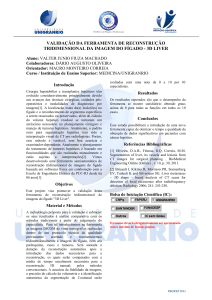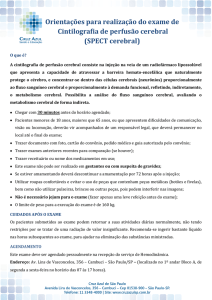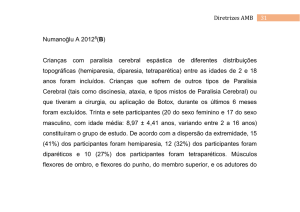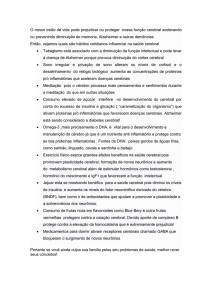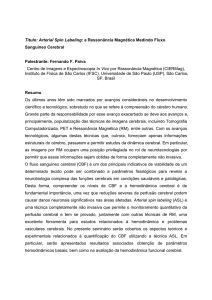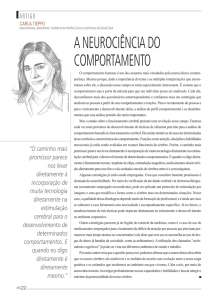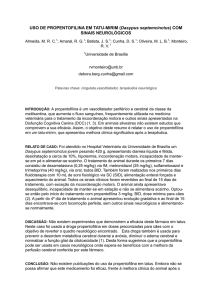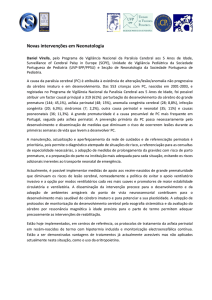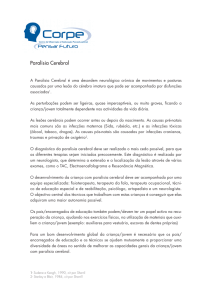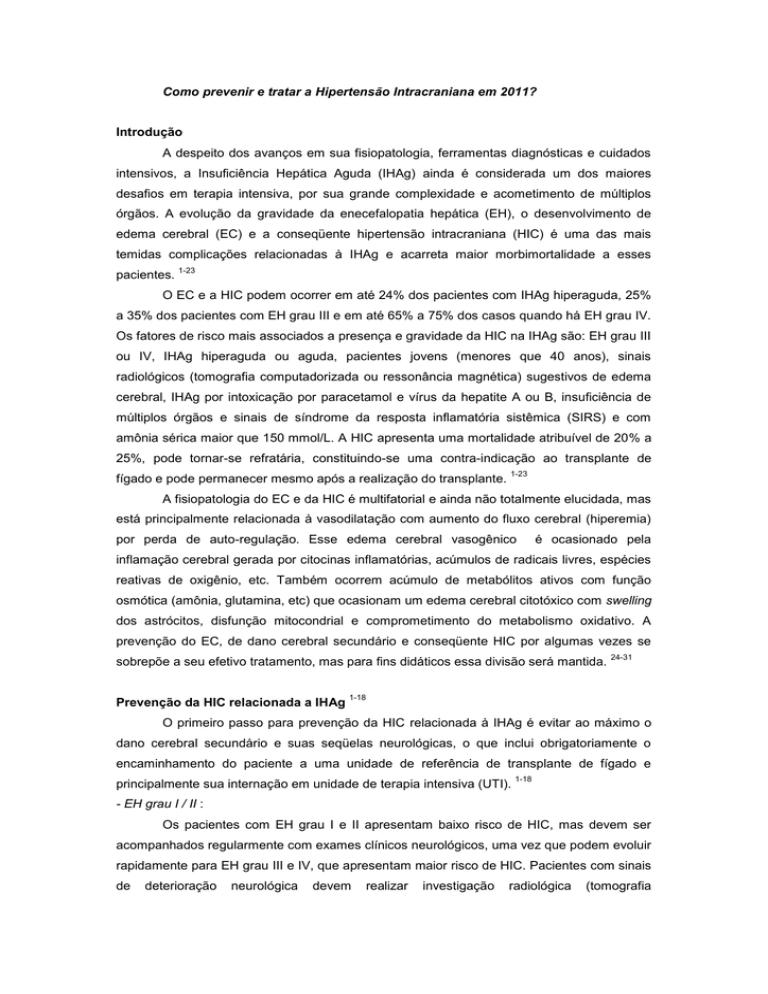
Como prevenir e tratar a Hipertensão Intracraniana em 2011?
Introdução
A despeito dos avanços em sua fisiopatologia, ferramentas diagnósticas e cuidados
intensivos, a Insuficiência Hepática Aguda (IHAg) ainda é considerada um dos maiores
desafios em terapia intensiva, por sua grande complexidade e acometimento de múltiplos
órgãos. A evolução da gravidade da enecefalopatia hepática (EH), o desenvolvimento de
edema cerebral (EC) e a conseqüente hipertensão intracraniana (HIC) é uma das mais
temidas complicações relacionadas à IHAg e acarreta maior morbimortalidade a esses
pacientes.
1-23
O EC e a HIC podem ocorrer em até 24% dos pacientes com IHAg hiperaguda, 25%
a 35% dos pacientes com EH grau III e em até 65% a 75% dos casos quando há EH grau IV.
Os fatores de risco mais associados a presença e gravidade da HIC na IHAg são: EH grau III
ou IV, IHAg hiperaguda ou aguda, pacientes jovens (menores que 40 anos), sinais
radiológicos (tomografia computadorizada ou ressonância magnética) sugestivos de edema
cerebral, IHAg por intoxicação por paracetamol e vírus da hepatite A ou B, insuficiência de
múltiplos órgãos e sinais de síndrome da resposta inflamatória sistêmica (SIRS) e com
amônia sérica maior que 150 mmol/L. A HIC apresenta uma mortalidade atribuível de 20% a
25%, pode tornar-se refratária, constituindo-se uma contra-indicação ao transplante de
fígado e pode permanecer mesmo após a realização do transplante.
1-23
A fisiopatologia do EC e da HIC é multifatorial e ainda não totalmente elucidada, mas
está principalmente relacionada à vasodilatação com aumento do fluxo cerebral (hiperemia)
por perda de auto-regulação. Esse edema cerebral vasogênico
é ocasionado pela
inflamação cerebral gerada por citocinas inflamatórias, acúmulos de radicais livres, espécies
reativas de oxigênio, etc. Também ocorrem acúmulo de metabólitos ativos com função
osmótica (amônia, glutamina, etc) que ocasionam um edema cerebral citotóxico com swelling
dos astrócitos, disfunção mitocondrial e comprometimento do metabolismo oxidativo. A
prevenção do EC, de dano cerebral secundário e conseqüente HIC por algumas vezes se
sobrepõe a seu efetivo tratamento, mas para fins didáticos essa divisão será mantida.
Prevenção da HIC relacionada a IHAg
24-31
1-18
O primeiro passo para prevenção da HIC relacionada à IHAg é evitar ao máximo o
dano cerebral secundário e suas seqüelas neurológicas, o que inclui obrigatoriamente o
encaminhamento do paciente a uma unidade de referência de transplante de fígado e
principalmente sua internação em unidade de terapia intensiva (UTI).
1-18
- EH grau I / II :
Os pacientes com EH grau I e II apresentam baixo risco de HIC, mas devem ser
acompanhados regularmente com exames clínicos neurológicos, uma vez que podem evoluir
rapidamente para EH grau III e IV, que apresentam maior risco de HIC. Pacientes com sinais
de
deterioração
neurológica
devem
realizar
investigação
radiológica
(tomografia
computadorizada ou ressonância magnética de crânio) e eletroencefalográfica (EEG) para
descartar outras possíveis causas de piora clínica (sangramento, convulsões, etc). Monitorar
e evitar ao máximo mesmo que curtos episódios de hipoxemia, hipoglicemia, hipertermia e
hipotensão arterial. Também deve-se controlar a agitação, mas evitar ao máximo
medicações com efeito sedativo, principalmente em alta dose e que possuam longa meiavida.
2, 9, 6, 12, 14, 17
- EH grau III / IV :
Por outro lado, pacientes com EH grau III ou IV devem ser prontamente intubados e
conectados a ventilação mecânica. Em seguida, inicia-se sedação / analgesia contínua com
objetivo de proteção de vias aéreas, garantir oxigenação adequada (SaO 2 ≥ 95% e paO2 ≥
70 mmHg), normocapnia (paCO2 30 – 35 mmHg), evitar agitação / desconforto e,
principalmente, redução do metabolismo e do consumo cerebral de oxigênio. O
posicionamento do paciente é medida simples mas efetiva na tentativa de não comprometer
o retorno venoso cerebral e piora do edema vasogênico. Para isso, a cabeça do paciente é
mantida centralizada no leito (posição neutra), com o cuidado de se evitar a compressão das
veias jugulares (inclusive fixações dos tubos traqueais e curativos de cateteres), e cabeceira
do leito em torno de 30°. Para todas as medidas supracitadas não existem estudos
específicos em IHAg, mas são consideradas um consenso em todas revisões e estudos
desta patologia.
1-23, 32-34
O propofol é considerado um agente neuro-protetor por ocasionar redução do fluxo
sanguíneo, metabolismo, consumo de oxigênio cerebral, redução de atividades convulsivas e
possuir efeito ação anti-inflamatória, anti-oxidante e anti-apoptótica cerebral, além de
apresentar curta meia-vida (o que possibilita re-avaliações neurológicas repetidas). Apesar
de não haver estudos adequados com sua utilização por longos períodos em IHAg (já que
sua metabolização é, preferencialmente, hepática) este ainda é considerado o agente de
escolha na sedação destes pacientes desde que se utilizem doses seguras (< 5 mg/kg/h) e
se mantenha uma monitorização constante apos infusões prolongadas pelo risco de
Síndrome de infusão de propofol (rabdomiólise, acidose metabólica grave e instabilidade
hemodinâmica).
35-38
Não existem estudos clínicos específicos comparando analgésicos em
IHAg, entretanto a infusão contínua de fentanil é agente preferencial na analgesia de
pacientes neurológicos por não alterar o limiar convulsivo e não possuir metabólitos ativos.
Sendo assim, o fentanil é o agente analgésico de escolha na IHAg, evitando sua utilização
em bolus pelo risco de redução da pressão arterial média e conseqüente redução da pressão
de perfusão cerebral (PPC).
39-41
A ventilação mecânica (VM) dos pacientes com IHAg segue as orientações de todos
os pacientes críticos e deve ser VM “protetora”, com baixas pressões de vias aéreas
(pressão de platô menor que 30 cmH2O), volume corrente de 4 a 6 ml/kg de peso ideal e
menor fração inspirada de oxigênio (mas evitando a hipoxemia). Entretanto, nos pacientes
com IHAg existe uma particularidade em relação à PEEP (Positive End Expiratory Pressure),
que deve ser mantida a menor possível para evitar redução do retorno venoso cerebral e
aumento da PIC. Estudos clínicos demonstram que aumento da PEEP em valores até
12cmH2O não ocasionam grandes repercussões negativas na PPC e na PIC.
42-45
Deve-se também realizar, o mais rapidamente possível, uma investigação
radiológica de crânio (TC ou RNM de crânio) e EEG com intuito de diagnosticar o mais
precocemente sinais de edema cerebral (com sinais indireto de HIC) e/ou crises convulsivas.
O estado de mal convulsivo não é tão freqüente em IHAg, mas as crises convulsivas podem
agravar ou precipitar episódios de HIC, por determinarem aumento significativo e por vezes
persistente do consumo de oxigênio e de vasodilatação cerebral. Estudos pequenos
relacionados a profilaxia de convulsões em IHAg possuem resultados não estatisticamente
significantes em relação à redução de crise convulsivas, melhora de sobrevida ou de
recuperação neurológica. Portanto, não é recomendado o uso rotineiro desta profilaxia em
IHAg, mas seu rastreamente contínuo (vídeo-EEG contínuo) ou intermitente (EEG diário)
deve ser sempre considerado.
46-54
Com o intuito de minimizar o desconforto do paciente,
deve-se realizar o mínimo possível de manipulação e quando estritamente necessárias
sempre após bolus de sedação, principalmente quando for realizar aspiração traqueal já que
esta ocasiona aumento da pressão intracraniana (PIC), comprovados por estudos em
pacientes neurológicos (não há estudos específicos em IHAg).
1-18
Considerando que a hiperamonemia é um dos pontos chaves na etiologia do EC e
da HIC, o uso de métodos farmacológicos de redução de sua produção/absorção (lactulona)
e aumento de sua metabolização/excreção (L-ornitina L-aspartato) podem ser considerados.
Apenas um estudo pequeno e retrospectivo (apresentado apenas como resumo em
congresso) avaliou o uso de lactulona em IHAg e falhou em demonstrar redução da
gravidade da EH, dias de internação em UTI, incidência de infecções, mortalidade do
paciente e indicação de transplante.
55
Acrescentado o risco de distensão abdominal,
dificultando o intra-operatório, possibilidade de aumentar pressão intra-abdominal e risco de
vômitos/aspiração, a lactulona não deve ser recomendada de rotina, dando-se preferência
pela utilização de enemas de retenção (glicerinados). Existem poucos estudos pequenos e
alguns experimentais que investigaram a utilização de L-ornitina L-aspartato (LOLA) em
IHAg, em que poucos demonstraram redução da amônia sérica e cerebral, mas nenhum
deles identificou efeito significativo em redução de mortalidade ou complicações
neurológicas. Portanto, ainda não ha evidencias suficientes para indicação rotineira de LOLA
em pacientes com IHAg.
56-62
Estudos demonstram que a presença de sinais de SIRS e quadros infecciosos
ocasionam aumento de citocinas pró-inflamatórias, óxido nítrico, com inflamação e
vasodilatação cerebral, além de aumento sérico e cerebral de amônia, precipitando episódios
de EH e aumento da PIC. Sendo assim, o uso de antibiótico profilático nos pacientes com
IHAg possibilita a prevenção dos episódios infecciosos e menor progressão da EH, reduz
suas implicações na HIC e deve incluir cobertura para cocos gram positivos (CGP), bacilos
gram negativos (BGN) e fungos.
5; 63-68
Vários estudos clínicos e experimentais demonstraram que o uso de vasopressina e
seus análagos (incluindo a terlipressina) ocasionam vasodilatação cerebral e aumento da
pressão de perfusão cerebral, mas com aumento da PIC (por perda da auto-regulação,
presente nos casos de IHAg). Recentemente, pequenos estudos clínicos foram controversos
em demonstrar este detrimento da PIC e microperfusão cerebral. Entretanto, esses dados
ainda não são suficientes para recomendação desses medicamentos em IHAg.
69-70
Não
existem outros estudos específicos comparando os diversos vasopressores em IHAg, mas
há uma preferência de escolha pelo uso da noradrenalina, por ser mais eficiente na correção
dos episódios de hipotensão arterial.
1-18; 71
A hiperglicemia e a hipertermia podem exacerbar a resposta inflamatória sistêmica,
aumentar radicais livres e espécies reativas de oxigênio e, com isso, precipitar episódios de
vasodilatação cerebral e aumento da PIC em pacientes com IHAg. Recomenda-se, então,
manter a normotermia (T axilar < 37.5°C) e estabelecer um controle glicêmico estrito,
mantendo a glicemia abaixo de 150mg/dL, com atenção ao risco de hipoglicemia (muito
freqüente nos pacientes com IHAg). Deve-se evitar a infusão de soluções hipotônicas e
corrigir episódios de hiponatremia que contribuem com o edema cerebral.
1-18
Estudo clínico
recente em IHAg demonstrou que quando o sódio sérico é mantido entre 145 a 155 mEq/L
os pacientes apresentam melhora hemodinâmica significativa e desenvolvem menos
episódios de HIC.
72
A hiperventilação profilática nao é recomendada em pacientes com IHAg
por não previnir HIC e poder ocasionar edema cerebral por redução oferta de oxigênio
cerebral.
73-74
A insuficiência renal aguda (IRA) pode ocorrer em 40% a 85% dos casos de IHAg e
está associada ao agravamento da EH e conseqüente EC, além de maior mortalidade.
Quando há necessidade de suporte renal dialítico, estudos em pacientes neurológicos e em
IHAg demonstram que o suporte contínuo é preferível em relação ao intermitente por levar a
menor variação da hemodinâmica e da osmolaridade sistêmica e cerebral com menor
interferência na PAM, na PPC e na PIC.
75-81
Moderada hipotermia (T axilar 35 - 36°C) é
observada durante suporte dialítico e não deve ser tratada.
A
atividade
anti-inflamatória
e
1-18
anti-oxidante,
com
possível
melhora
da
microcirculação e inflamação cererbal da N-acetilcisteína (NAC) vem estimulando seu estudo
clínico na prevenção da HIC na IHAg de etiologia não-paracetamol em doses semelhantes à
etiologia por paracetamol. O estudo com melhor nível de evidencia é randomizado, mas não
duplo-cego e falhou em demonstrar melhora de sobrevida em 3 semanas e recuperação
espontânea em pacientes com EH grau III e IV, sendo observada apenas em pacientes com
EH grau I e II. Entretanto, devido à grande segurança em sua utilização e à sua eficácia, o
uso de NAC pode ser considerado em pacientes com IHAg de etiologia não-paracetamol.
85
82-
Estudos clínicos também falharam em demonstrar que o uso de corticóides com intuito de
reduzir a inflamação cerebral pudessem reduzir a incidência de episódios de HIC e não
devem ser utilizados com essa finalidade na IHAg.
Tratamento da HIC relacionada a IHAg
86
1-18
A indicação de monitorização da PIC em pacientes com IHAg ainda é controversa na
literatura. Nenhum estudo clínico demonstrou redução de mortalidade nos casos de HIC
comprovada, com um risco de até 10% a 20% de complicações relacionados ao cateter de
PIC (que podem ser minimizadas evitando-se os cateteres ventriculares e correção efetiva
dos distúrbios de coagulação). Sendo assim, a monitorização invasiva da PIC deve ser
orientada de acordo com o protocolo de tratamento de cada instituição, além de ser
considerada em pacientes que possuam vários fatores de risco para HIC (como descritos na
introdução) e com sinais indiretos de HIC em avaliações não invasivas da PIC.
1-18; 87-93
A avaliação indireta da PIC pode ser, inicialmente, realizada por exames radiológicos
como CT, RNM ou de crânio e vários estudos recentes correlacionam as imagens
radiológicas com a amônia sérica e a gravidade da EH. Outra possibilidade é o Doppler
transcraniano (DTC) que, além da avaliação não invasiva da PIC, faz uma avaliação da
macro e microcirculação cerebral, do grau de perda da auto-regulação e da hiperemia
(podendo inferir a gravidade da IHAg com alta probabilidade de HIC).
94-97
Um estudo recente
demonstrou a boa acurácia da Ultrassonografia da bainha do nervo óptico (USG-BNO) na
avaliação não invasiva da PIC em pacientes com IHAg.
98-104
Durante o tratamento dos paciente com IHAg e risco de HIC, a PPC deve ser
mantida entre 50 – 60 mmHg evitando tanto a isquemia quanto a hiperemia, já que ambas
contribuem com o edema cerebral. Quando a PPC mantém-se por mais de 2 horas abaixo de
40mmHg está associada a herniação cerebral e pior prognóstico neurológico. O tratamento
inclui as medidas gerais descritas anteriormente na prevenção e medidas específicas
quando identificam-se sinais diretos de HIC (PIC > 25 mmHg por mais de 5 minutos) ou
sinais indiretos na avaliação não invasiva.
1-18
A primeira intervenção considerada uma
terapia de emergência é a hiperventilação controlada e por curto período (risco de isquemia
cerebral se por longo período), que possibilita a redução de CO 2 e vasoconstricção cerebral
com redução da PIC, até que outra medida seja instituída.
105-109
O manitol ainda é considerado por vários autores a primeira-linha de tratamento da
HIC na IHAg e tem efeito osmótico intravascular que ocasiona redução da água cerebral e
conseqüente redução da PIC. Na maioria das instituições a solução disponível é a 20% e
pode ser utilizado na dose de 0.25 – 1 g/kg de peso em 10 minutos, podendo ser repetida
outras vezes caso haja necessidade, desde que seja monitorizada a osmolaridade sérica do
paciente e esta permaneça abaixo de 320 mmOsm/L. Recentemente, vários estudos clínicos
em pacientes neurológicos vem demonstrando um efeito similar ou superior das Soluções
Salinas Hipertônicas (SSH) em relação ao manitol. Além do efeito osmótico (com redução da
água cerebral), a SHH possui efeito na melhora da viscosidade sanguínea, na reologia das
hemácias e na redução do edema do endotélio / tecidual (com melhora da oferta de oxigênio
aos tecidos), na modulação resposta inflamatória celular, na atenuação do stress oxidativo e
na melhora da contratilidade cardíaca. Existem estudos com SSH a 3% (10 ml/kg de peso),
7.5% (4 ml/kg de peso) e 23.4% (2 ml/kg de peso) administradas em 10 a 30 minutos e sua
administração é mais facilmente monitorizada através do sódio sérico (manter Na sérico <
160 mEq/L).
110-118
Em casos refratários a essas medidas, podemos utilizar duas estratégias: a
Hipotermia moderada (32°C a 33°C) e o Coma Barbitúrico (CB). Estudos clínicos em
pacientes com IHAg demonstram que a hipotermia possui efeitos em reduzir a amônia e
glutamato cerebral, o fluxo sanguíneo cerebral, o metabolismo e consumo de oxigênio e a
produção de citocinas pró-inflamatórias, minimizando os fatores que contribuem com o
aumento da PIC. Os efeitos colaterais da hipotermia (infecções, arritmias, distúrbios
eletrolíticos, dentre outros) não foram mais freqüentes nos estudos com IHAg.
119-126
O CB
que geralmente é induzido com tiopental (na dose de 5 – 10 mg/kg bolus e manutenção de 3
– 5 mg/kg/h) é uma alternativa em pacientes neurológicos com HIC refratária, entretanto
apenas um estudo observacional descreveu esta como uma possibilidade no tratamento em
IHAg. Deve-se estar atento às possíveis complicações deletérias deste tratamento (como
hipotensão arterial, inotropismo negativo e imunossupressão), mas ainda é uma alternativa
terapêutica nos pacientes com IHAg e HIC refratária.
127-131
A administração de indometacina, a Diálise Hepática (DH) e a Hepatectomia com
Shunt Porto-Cava Temporário (HSPCT) podem ser consideradas terapias de resgate em
pacientes com IHAg e HIC refratária a todas medidas supracitadas. A indometacina é um
anti-inflamatório não esteroidal inibidor da cicloxigenase 2 que ocasiona vasoconstricção
cerebral e redução da atividade anti-inflamatória. Alguns pequenos estudos observacionais
em IHAg demonstraram redução efetiva da PIC, entretanto devem ser utilizados com cautela
devido aos riscos de sangramento e insuficiência renal aguda.
132-134
A DH hepática é um
sistema bioartificial de diálise onde o sangue é dialisado com uma membrana altamente
permeável e contra um fluxo de dialisato enriquecido em albumina. Isso fornece vantagem
em relação às diálises habituais, por propiciar a retirada de bilirrubina, aminoácidos
aromáticos, citocinas inflamatórias e de toxinas / substâncias insolúveis em água. Possuem
efeito de redução do status inflamatório, hiperamonemia, com melhora da hemodinâmica, da
encefalopatia hepática e da PIC. Sistemas de DH como MARS® (Molecular Adsorbent
Recirculating System) e Prometheus® já foram avaliados em pequenos estudos clínicos
observacionais em IHAg com alguns deles evidenciando melhora do quadro hemodinâmico e
neurológico mas sem demonstrar impacto em recuperação espontânea, sobrevida dos
pacientes ou recuperação neurológica.
135-141
As HSPCT podem ser a última alternativa,
porém estritamente temporária até a realização do transplante, em pacientes com IHAg que
desenvolvem a “Síndrome do Fígado Tóxico”, uma cascata inflamatória devastadora.
Existem na literatura algumas séries de casos com resultados controversos, não devendo ser
uma alternativa de rotina.
142-145
Sugestão de recomendações na Prevenção/Tratamento da HIC na IHAg com EH grau III/IV
PREVENÇÃO HIC
Intubação traqueal
STATUS
Indicado
Indicado
Indicado
Indicado
COMENTÁRIOS
Evitar hipotensão durante procedimento.
Utilizar baixas doses de propofol.
Manter: SaO2 ≥ 95% e paO2 ≥ 70 mmHg.
Manter paCO2 30-35 mmHg.
Não indicada Hiperventilação profilática.
Evitar também curativos ou fixações que
possam comprimir a veia jugulas.
Rastrear Síndrome de Infusão do Propofol.
Evitar uso em bolus (risco redução PPC)
Manipular o paciente o mínimo possível
Evitar hipoxemia
Normocapnia
Indicado
Indicado
Cabeça com posição
centralizada e cabeceira a 30°
Sedação – propofol
Analgesia – fentanil
Sedação em bolus prémanipulações
PEEP baixa
Tomografia ou ressonância de
crânio
Eletroencefalograma
Profilaxia de convulsões
Lactulona
L-ornitina L-aspartato
Antibiótico profilático se
houver sinais SIRS
Vasopressina e seus análagos
Controle glicêmico (<
150mg/dL)
Corrigir hipertermia
Corrigir hiponatremia
Substituição renal contínua
N-acetilcisteína
Indicado
Indicado
Indicado
PEEP até 12 cmH2O.
Rastrear sinais indiretos de edema cerebral.
Indicado
Não indicado
Não indicado
Não indicado
Indicado
Se possível vídeo-EEG contínuo.
Monitorização com EEG diário ou contínuo.
Considerar uso de enema de retenção.
Não indicado
Noradrenalina é o vasopresor de escolha
Evitar a hipoglicemia
Indicado
Indicado
Indicado
Considerado
Manter T axilar < 37.5°C
Manter sódio sérico 145-155 mEq/L
Se houver hipotermia não corrigir
Dose semelhante a intoxicação por
paracetamol
Pode ser necessário seu uso no choque
séptico.
Avaliação não invasiva da PIC (sinais
indiretos de HIC)
COMENTÁRIOS
Por poucos minutos é considerado
tratamento emergência evitando herniações
Manter osmolaridade sérica <320mmOsm/L
Manter Na sérico < 160 mEq/L
Corticoesteróides
Não indicado
Doppler Transcraniano e USG
bainha nervo óptico
TRATAMENTO HIC
Hiperventilação por curto
período
Manitol 20% (0.25-1g / kg)
SSH 3% (10 ml/kg), 7.5% (4
ml/kg) ou 23.4% (2 ml/kg) em
10-30 minutos
Hipotermia moderada (3233°C)
Coma barbitúrico (tiopental: 510 mg/kg bolus e manutenção
de 3-5 mg/kg/h)
Indometacina (25mg bolus)
Considerado
Dialise hepática
Hepatectomia com shunt
porto-cava temporário
Considerado
Discutível
STATUS
Indicado
Indicado
Indicado
Indicado
Indicado
Considerado
Cobertura para CGP, BGN e fungos
Monitorar efeitos colaterais: infecções,
arritmias, distúrbios eletrolíticos, etc
Monitorar efeitos colaterais: hipotensão
arterial, inotropismo negativo e
imunossupressão, hipocalemia, etc
Terapia de resgate pelo risco IRA e
sangramento
Terapia de resgate, se disponível
Tratamento de resgate controverso
Referencias bibliográficas:
1. Razonable RR, Findlay JY, O'Riordan A, Burroughs SG, Ghobrial RM, Agarwal B,
Davenport A, Gropper M. Critical care issues in patients after liver transplantation.
Liver Transpl. 2011; 17(5):511-27.
2. Frontera JA, Kalb T. Neurological management of fulminant hepatic failure. Neurocrit
Care. 2011; 14(2):318-27.
3. Rabinstein AA. Treatment of brain edema in acute liver failure. Curr Treat Options
Neurol. 2010; 12(2): 129-41.
4. McDowell Torres D, Stevens RD, Gurakar A. Acute liver failure: a management
challenge for the practicing gastroenterologist. Gastroenterol Hepatol (N Y). 2010;
6(7): 444-50.
5. Kitzberger R, Funk GC, Holzinger U, Miehsler W, Kramer L, Kaider A, Ferenci P,
Madl C. Severity of organ failure is an independent predictor of intracranial
hypertension in acute liver failure. Clin Gastroenterol Hepatol. 2009; 7(9): 1000-6.
6. Stravitz RT. Critical management decisions in patients with acute liver failure. Chest.
2008; 134(5): 1092-102.
7. Wendon J, Lee W. Encephalopathy and cerebral edema in the setting of acute liver
failure: pathogenesis and management. Neurocrit Care. 2008;9(1):97-102.
8. Kramer DJ, Canabal JM, Arasi LC. Application of intensive care medicine principles
in the management of the acute liver failure patient. Liver Transpl. 2008;14 Suppl
2:S85-9.
9. Auzinger G, Wendon J. Intensive care management of acute liver failure. Curr Opin
Crit Care. 2008; 14(2):179-88.
10. Larsen FS, Wendon J. Prevention and management of brain edema in patients with
acute liver failure. Liver Transpl. 2008; 14 Suppl 2:S90-6.
11. Stravitz RT, Kramer AH, Davern T, Shaikh AO, Caldwell SH, Mehta RL, Blei AT,
Fontana RJ, McGuire BM, Rossaro L, Smith AD, Lee WM; Acute Liver Failure Study
Group. Intensive care of patients with acute liver failure: recommendations of the U.S.
Acute Liver Failure Study Group. Crit Care Med. 2007; 35(11): 2498-508.
12. Detry O, De Roover A, Honore P, Meurisse M. Brain edema and intracranial
hypertension in fulminant hepatic failure: Pathophysiology and management. World J
Gastroenterol. 2006; 12(46): 7405-12.
13. Han MK, Hyzy R. Advances in critical care management of hepatic failure and
insufficiency. Crit Care Med. 2006; 34(9 Suppl): S225-31.
14. Raghavan M, Marik PE. Therapy of intracranial hypertension in patients with
fulminant hepatic failure. Neurocrit Care. 2006; 4(2): 179-89.
15. Polson J. and William M. Lee. American Association for the Study of Liver Disease.
AASLD Position Paper: The Management of Acute Liver Failure Hepatology. 2005;
41(5): 1179-97.
16. Jalan R. Acute liver failure: current management and future prospects. J Hepatol.
2005; 42 Suppl(1):S115-23.
17. Jalan R. Intracranial hypertension in acute liver failure: pathophysiological basis of
rational management. Semin Liver Dis. 2003; 23(3): 271-82.
18. Rahman T, Hodgson H. Clinical management of acute hepatic failure. Intensive Care
Med. 2001; 27(3): 467-76.
19. Hanid MA, Davies M, Mellon PJ, Silk DB, Strunin L, Mc- Cabe JJ, Williams R. Clinical
monitoring of intracranial pressure in fulminant hepatic failure. Gut 1980; 21:866- 869.
20. Ware AJ, D’Agostino AN, Combes B. Cerebral edema: A major complication of
massive hepatic necrosis. Gastroenterology 1971; 61:877-884.
21. O’Grady JG, Schalm SW, Williams R: Acute liver failure: Redefining the syndromes.
Lancet 1993; 342:273–275.
22. Munoz SJ. Difficult management problems in fulminant hepatic failure. Semin Liver
Disease 1993;13:395-413.
23. O’Brien CJ, Wise RJS, O’Grady JG, Williams R. Neurological sequelae in patients
recovered from fulminant hepatic failure. Gut 1987; 28:93-95.
24. Butterworth RF. Hepatic encephalopathy: a central neuroinflammatory disorder?
Hepatology 2011; 53:1372-1376.
25. Nguyen JH. Subtle BBB alterations in brain edema associated with acute liver failure.
Neurochem Int. 2010 Jan; 56(2):203-4.
26. Márquez-Aguirre AL, Canales-Aguirre AA, Gómez-Pinedo U, Gálvez-Gastélum FJ.
Molecular aspects of hepatic encephalopathy. Neurologia. 2010 May;25(4):239-47.
27. Bjerring PN, Eefsen M, Hansen BA, Larsen FS. The brain in acute liver failure. A
tortuous path from hyperammonemia to cerebral edema. Metab Brain Dis. 2009;
24(1): 5-14.
28. Bernal W, Hall C, Karvellas CJ, Auzinger G, Sizer E, Wen- don J. Arterial ammonia
and clinical risk factors for encephalopathy and intracranial hypertension in acute liver
failure. Hepatology 2007; 46:1844-1852.
29. Jalan R. Pathophysiological basis of therapy of raised intracranial pressure in acute
liver failure. Neurochem Int. 2005; 47(1-2): 78-83.
30. Jalan R. Intracranial hypertension in acute liver failure: pathophysiological basis of
rational management. Semin Liver Dis. 2003; 23(3): 271-82.
31. Vaquero J, Chung C, Cahill ME, Blei AT. Pathogenesis of hepatic encephalopathy in
acute liver failure. Semin Liver Disease 2003; 23:259-269.
32. Ng I, Lim J, Wong HB. Effects of head posture on cerebral hemodynamics: its
influences on intracranial pressure, cerebral perfusion pressure, and cerebral
oxygenation. Neurosurgery. 2004; 54(3): 593-7.
33. Mavrocordatos P, Bissonnette B, Ravussin P: Effects of neck position and head
elevation on intracranial pressure in anaesthetized neurosurgical patients:
Preliminary results. J Neurosurg Anesthesiol 2000; 12:10 –14.
34. Herrine S, Northrup B, Bell R, et al: The effect of head elevation on cerebral perfusion
pressure in fulminant hepatic failure. Hepatology 1995; 22:289A
35. Iyad K, Nseir W, Alexandrov O, Isakson A, Mysh V, Dabbah K, Assy N. Sub-clinical
hepatic encephalopathy in cirrhotic patients is not aggravated by sedation with
propofol compared to midazolam: A randomized controlled study. Assy Nimer.
Journal of Hepatology 2011; 52: 72–77.
36. Adembri C, Venturi L and Pellegrini-Giampietro DE. Neuroprotective Effects of
Propofol in Acute Cerebral Injury. CNS Drug Reviews 2007; 13 (3): 333–351.
37. D. Takizawa, E. Sato, H. Hiraoka, A. Tomioka, K. Yamamoto, R. Horiuchi and F.
Goto. Changes in apparent systemic clearance of propofol during transplantation of
living related donor liver. British Journal of Anaesthesia 95 (5): 643–7 (2005).
38. E.F.M. Wijdicks and S.L. Nyberg. Propofol to Control Intracranial Pressure in
Fulminant Hepatic Failure. Transplantation Proceedings, 34, 1220–1222 (2002).
39. Abdennour L and Puybasset L. Sedation and analgesia for brain injured patient.
Annales Francaises d’Anesthesie et de Reanimation 27 (2008) 596–603.
40. Nadal M, Munar F, Poca MA, Sahuquillo J, Garnacho A, Rossello J. Cerebral
Hemodynamic Effects of Morphine and Fentanyl in Patients with Severe Head Injury Absence of Correlation to Cerebral Autoregulation. Anesthesiology 2000; 92 (1).
41. Richard J Sperry, Peter L B alley, Mark V Reichman, John C Peterson, Peggy B
Ptersen, Nathan L Pace. Fentanyl and Sulfentanil increase Intracranial Pressure in
Head Trauma patients. Anesthesiology 1992; 77: 416-420.
42. Xiang-yu Zhang, Qi-xing Wang and Hai-rong Fan. Impact of positive end-expiratory
pressure on cerebral injury patients with hypoxemia. Am J Emerg Med. 2010 Apr 30.
43. Caricato A, Conti G, Corte FD, Mancino A, Santilli F, Sandroni C, Proietti R and
Antonelli M. Effects of PEEP on the Intracranial System of Patients With Head Injury
and Subarachnoid Hemorrhage: The Role of Respiratory System Compliance. J
Trauma. 2005;58:571–576.
44. Huynh T, Messer M, Sing RF, Miles W, Jacobs DG and Thomason MH. Positive EndExpiratory Pressure Alters Intracranial and Cerebral Perfusion Pressure in Severe
Traumatic Brain Injury. J Trauma. 2002;53:488–493.
45. Georgiadis D, Schwarz S, Baumgartner RW, Veltkamp R and Schwab S. Influence of
Positive End-Expiratory Pressure on Intracranial Pressure and Cerebral Perfusion
Pressure in Patients With Acute Stroke. Stroke 2001, 32:2088-2092.
46. Hunter GR, Young GB. Recovery of awareness after hyperacute hepatic
encephalopathy with "flat" EEG, severe brain edema and deep coma. Neurocrit Care.
2010 Oct;13(2):247-51.
47. McKinney AM, Lohman BD, Sarikaya B, Uhlmann E, Spanbauer J, Singewald T,
Brace JR. Acute hepatic encephalopathy: diffusion-weighted and fluid-attenuated
inversion recovery findings, and correlation with plasma ammonia level and clinical
outcome. AJNR Am J Neuroradiol. 2010; 31(8):1471-9.
48. McPhail MJ, Taylor-Robinson SD. The role of magnetic resonance imaging and
spectroscopy in hepatic encephalopathy. Metab Brain Dis. 2010; 25(1):65-72.
49. Poveda MJ, Bernabeu A, Concepción L, Roa E, de Madaria E, Zapater P, PérezMateo M, Jover R. Brain edema dynamics in patients with overt hepatic
encephalopathy A magnetic resonance imaging study. Neuroimage. 2010 Aug
15;52(2):481-7.
50. Bass L, Keiding S, Munk OL. Benefits and risks of transforming data from dynamic
positron emission tomography, with an application to hepatic encephalopathy. J
Theor Biol. 2009; 256(4):632-6.
51. Friedman D, Claassen J, Hirsch LJ. Continuous electroencephalogram monitoring in
the intensive care unit. Anesth Analg. 2009; 109(2):506-23.
52. Rabinstein AA. Continuous electroencephalography in the medical ICU. Neurocrit
Care. 2009; 11(3):445-6.
53. Stewart CA, Reivich M, Lucey MR, Gores GJ. Neuroimaging in hepatic
encephalopathy. Clin Gastroenterol Hepatol. 2005; 3(3):197-207.
54. Munoz SJ, Robinson M, Northrup B, et al: Elevated intracranial pressure and
computed tomography of the brain in fulminant hepatocellular failure. Hepatology
1991; 13: 209 –212.
55. L. Alba, J.E. Hay, P. Angulo, W.M. Lee . Lactulose therapy in acute liver failure.
Journal of Hepatology April 2002 (Vol. 36, Supplement 1, Page 33).
56. Schmid M, Peck-Radosavljevic M, Konig F, Mittermaier C, Gangla A and Ferenci P. A
double-blind, randomized, placebo-controlledtrial of intravenous L-ornithineaspartateon posturalcontrolin patients with cirrhosis. Liver Inlernational (2010).
57. Acharya SK, Bhatia V, Sreenivas V, Khanal S and Panda SK. Efficacy of L-Ornithine
L-Aspartate in Acute Liver Failure: A Double-Blind, Randomized, Placebo-Controlled
Study. Gastroenterology 2009;136:2159–2168.
58. Qian Jiang, Xue-Hua Jiang, Ming-Hua Zheng and Yong-Ping Chen. L-Ornithine-Laspartate in the management of hepatic encephalopathy: A meta-analysis. Journal of
Gastroenterology and Hepatology 24 (2009) 9–14.
59. Pilar LT and Mercado RS. L-ORNITHINE ASPARTATE AMONG CIRRHOTIC
PATIENTS WITH HEPATIC ENCEPHALOPATHY: DOES IT MAKE A
DIFFERENCE? Phil J of Gastroenterology 2006; 2:87-94.
60. Poo JL, Góngora J, Sánchez-Ávila F, Aguilar-Castillo S, García-Ramos G,
Fernández-Zertuche M, Rodríguez-Fragoso L, Uribe M. Efficacy of oral L-ornithine-Laspartate in cirrhotic patients with hyperammonemic hepatic encephalopathy. Results
of a randomized, lactulose-controlled study. Ann Hepatol 2006;5:281–288.
61. Kircheis G, Wettstein M, Dahl S, et al. Clinical efficacy of L-ornithine-L-aspartate in
the management of hepatic encephalopathy. Metab Brain Dis 2002; 17:453– 462.
62. Rose C, Michalak A, Rao KV, et al. L-ornithine-L-aspartate lowers plasma and
cerebrospinal fluid ammonia and prevents brain edema in rats with acute liver failure.
Hepatology 1999;30:636–640.
63. Jha AK, Nijhawan S, Suchismita A. Sepsis in acute on chronic liver failure. Dig Dis
Sci. 2011; 56(4):1245-6.
64. Karvellas CJ, Pink F, McPhail M, Austin M, Auzinger G, Bernal W, Sizer E,
Kutsogiannis DJ, Eltringham I, Wendon JA. Bacteremia, acute physiology and
chronic health evaluation II and modified end stage liver disease are independent
predictors of mortality in critically ill nontransplanted patients with acute on chronic
liver failure. Crit Care Med. 2010; 38(1):121-6.
65. Karvellas CJ, Pink F, McPhail M, Cross T, Auzinger G, Bernal W, Sizer E,
Kutsogiannis DJ, Eltringham I, Wendon JA. Predictors of bacteraemia and mortality in
patients with acute liver failure. Intensive Care Med. 2009; 35(8):1390-6.
66. Shawcross DL, Davies NA, Williams R, Jalan R. Systemic inflammatory response
exacerbates the neuropsychological effects of induced hyperammonemia in cirrhosis.
J Hepatol. 2004; 40(2):247-54.
67. Vaquero J, Polson J, Chung C, Helenowski I, Schiodt FV, Reisch J, Lee WM, Blei AT.
Infection and the progression of hepatic encephalopathy in acute liver failure.
Gastroenterology. 2003; 125(3):755-64.
68. Rolando N, Wade J, Davalos M, Wendon J, Philpott-Howard J, Williams R. The
systemic inflammatory response syndrome in acute liver failure. Hepatology. 2000;
32(4 Pt 1):734-9.
69. Eefsen M, Dethloff T, Frederiksen HJ, Hauerberg J, Hansen BA, Larsen FS.
70.
71.
72.
73.
74.
75.
76.
77.
78.
79.
80.
81.
82.
83.
84.
85.
86.
87.
88.
Comparison of terlipressin and noradrenalin on cerebral perfusion, intracranial
pressure and cerebral extracellular concentrations of lactate and pyruvate in patients
with acute liver failure in need of inotropic support. Journal of Hepatology 47 (2007)
381–386.
Shawcross DL, Davies NA, Mookerjee RP, Hayes PC, Williams R, Lee A and Jalan
R. Worsening of Cerebral Hyperemia by the Administration of Terlipressin in Acute
Liver Failure With Severe Encephalopathy. Hepatology 2004;39:471– 475.
Sookplung P, Siriussawakul A, Malakouti A, Sharma D, Wang J, Souter MJ, Chesnut
RJ, Vavilala MS. Vasopressor Use and Effect on Blood Pressure After Severe Adult
Traumatic Brain Injury. Neurocrit Care (2011) 15:46–54.
Murphy N, Auzinger G, Bernel W and Wendon J. The Effect of Hypertonic Sodium
Chloride on Intracranial Pressure in Patients With Acute Liver Failure. Hepatology
2004; 39:464 – 470.
Ellis A, Wendon J. Circulatory, respiratory, cerebral, and renal derangements in acute
liver failure: Pathophysiology and management. Semin Liver Disease 1996;16:379387.
Ede RJ, Gimson AE, Bihari D, Williams R. Controlled hyperventilation in the
prevention of cerebral oedema in fulminant hepatic failure. J Hepatol 1986;2:43-51.
Davenport A. Continuous Renal Replacement Therapies in Patients with Liver
Disease. Seminars in Dialysis—Vol 22, No 2 (March–April) 2009.
Davenport A. Continuous Renal Replacement Therapies in Patients with Acute
Neurological Injury. Seminars in Dialysis—Vol 22, No 2 (March–April) 2009.
Davenport A. Practical guidance for dialyzing a hemodialysis patient following acute
brain injury. Hemodialysis International 2008; 12:307–312.
Davenport A, Will EJ, Davison AM. Effect of renal replacement therapy on patients
with combined acute renal and fulminant hepatic failure. Kidney Int Suppl. 1993
Jun;41:S245-51.
Davenport A, Will EJ, Davidson AM. Improved cardiovascular stability during
continuous modes of renal replacement therapy in critically ill patients with acute
hepatic and renal failure. Crit Care Med. 1993 Mar;21(3):328-38.
Davenport A, Will EJ, Davison AM. Early changes in intracranial pressure during
haemofiltration treatment in patients with grade 4 hepatic encephalopathy and acute
oliguric renal failure. Nephrol Dial Transplant. 1990;5(3):192-8.
Davenport A, Will EJ, Davison AM, Swindells S, Cohen AT, Miloszewski KJ,
Losowsky MS. Changes in intracranial pressure during haemofiltration in oliguric
patients with grade IV hepatic encephalopathy. Nephron. 1989;53(2):142-6.
Bémeur C, Vaquero J, Desjardins P and Butterworth RF. N-Acetylcysteine attenuates
cerebral complications of non-acetaminophen-induced acute liver failure in mice:
antioxidant and anti-inflammatory mechanisms. Metab Brain Dis (2010) 25:241–249.
WILLIAM M. LEE, LINDA S. HYNAN, LORENZO ROSSARO, ROBERT J.
FONTANA, R. TODD STRAVITZ, ANNE M. LARSON, TIMOTHY J. DAVERN II,
NATALIE G. MURRAY, TIMOTHY McCASHLAND, JOAN S. REISCH, PATRICIA R.
ROBUCK and the Acute Liver Failure Study Group. Intravenous N-Acetylcysteine
Improves Transplant-Free Survival in Early Stage Non-Acetaminophen Acute Liver
Failure. Gastroenterology 2009;137:856–864.
Walsh TS, Hopton P, Philips BJ, Mackenzie SJ, Lee A. The effect of N-acetylcysteine
on oxygen transport and uptake in patients with fulmi- nant hepatic failure.
Hepatology 1998; 27:1332-1340.
Harrison PM, Wendon JA, Gimson AES, Alexander GJ, Williams R. Improvement by
acetylcysteine of haemodynamics and oxygen transport in fulminant hepatic failure. N
Engl J Med 1991;324:1852-1858.
J CANALESE, A E S GIMSON, C DAVIS, P J MELLON, M DAVIS, and ROGER
WILLIAMS. Controlled trial of dexamethasone and mannitol for the cerebral oedema
of fulminant hepatic failure. Gut,1982,23,625-629.
Alejandra T. Rabadán, Natalia Spaho, Diego Hernández, Adrián Gadano, Eduardo
de Santibañes. Intraparenchymal IntracranIal pressure monItorIng In patIents wIth
acute lIver failure. Arq Neuropsiquiatr 2008;66(2-B):374-377.
Javier Vaquero, Robert J. Fontana, Anne M. Larson, Nathan M.T. Bass, Timothy J.
Davern, A. Obaid Shakil, Steven Han, M. Edwyn Harrison, Todd R. Stravitz, Santiago
Munoz, Robert Brown William M. Lee and Andres T. Blei. Complications and Use of
Intracranial Pressure Monitoring in Patients With Acute Liver Failure and Severe
Encephalopathy. Liver Transpl 2005;11:1581-1589.
89. Vaquero J, Fontana RJ, Larson AM, Bass NMT, Davern TJ, Shakil AO, Han S,
Harrison ME, Stravitz TR, Munoz S, Brown R, Lee WM, Blei AT. Complications and
use of intracranial pressure monitoring in patients with acute liver failure and severe
encephalopathy. Liver Transpl 2005;11:1581-1589.
90.
Keays RT, Alexander GJ, Williams R. The safety and value of extradural
intracranial pressure monitors in fulminant hepatic failure. J Hepatol. 1993;18(2):205–
9. 25.
91.
Blei AT, Olafsson S, Webster S, et al. Complications of intracranial pressure
monitoring in fulminant hepatic failure. Lancet.1993;341(8838):157–8.
92.
Lidofsky SD, Bass NM, Prager MC, et al. Intracranial pressure monitoring and
liver transplantation for fulminant hepatic failure. Hepatology. 1992;16(1):1–7.
93. M A HANID, M DAVIES, P J MELLON, D B A SILK, L STRUNIN, JJMcCABE, AND
ROGER WILLIAMS. Clinical monitoring ofi ntracranial pressure in fulminant hepatic
failure. Gut, 1980, 21, 866-869.
94. Figaji AA, Zwane E, Fieggen AG, et al. Transcranial Doppler pulsatility index is not a
reliable indicator of intracranial pressure in children with severe traumatic brain injury.
Surg Neurol. 2009; 72(4):389–94.
95. Abdo A, Lopez O, Fernandez A, et al. Transcranial Doppler sonography in fulminant
hepatic failure. Transplant Proc 2003; 35:1859–1860.
96. Strauss GI, Moller K, Holm S, Sperling B, Knudsen GM, Larsen FS. Transcranial
Doppler sonography and internal jugular bulb saturation during hyperventilation in
patients with fulminant hepatic failure. Liver Transpl 2001;7:352–358.
97. Sidi A, Mahla ME. Noninvasive monitoring of cerebral perfusion by transcranial
Doppler during fulminant hepatic failure and liver transplantation. Anesth Analg. 1995
Jan;80(1):194-200.
98. Moretti R, Pizzi B. Ultrasonography of the optic nerve in neurocritically ill patients.
Acta Anaesthesiol Scand. 2011 Jul;55(6):644-52.
99. Dubourg J, Javouhey E, Geeraerts T, Messerer M, Kassai B. Ultrasonography of
optic nerve sheath diameter for detection of raised intracranial pressure: a systematic
review and meta-analysis. Intensive Care Med. 2011 Jul;37(7):1059-68. Epub 2011
Apr 20.
100.
Geeraerts T, Merceron S, Benhamou D, Vigué B, Duranteau J. Non-invasive
assessment of intracranial pressure using ocular sonography in neurocritical care
patients. Intensive Care Med. 2008 Nov;34(11):2062-7.
101.
Soldatos T, Karakitsos D, Chatzimichail K, Papathanasiou M, Gouliamos A,
Karabinis A. Optic nerve sonography in the diagnostic evaluation of adult brain injury.
Crit Care. 2008;12(3):R67.
102.
Bindi ML, Biancofiore G, Esposito M, Meacci L, Bisà M, Mozzo R, Urbani L,
Catalano G, Montin U, Filipponi F. Transcranial doppler sonography is useful for the
decision-making at the point of care in patients with acute hepatic failure: a single
centre's experience. J Clin Monit Comput. 2008 Dec;22(6):449-52.
103.
Geeraerts T, Launey Y, Martin L, Pottecher J, Vigué B, Duranteau J,
Benhamou D. Ultrasonography of the optic nerve sheath may be useful for detecting
raised intracranial pressure after severe brain injury. Intensive Care Med. 2007
Oct;33(10):1704-11.
104.
Helmke K, Burdelski M, Hansen HC. Detection and monitoring of intracranial
pressure dysregulation in liver failure by ultrasound. Transplantation. 2000 Jul
27;70(2):392-5.
105.
JAE HONG LEE, DANIEL F. KELLY, MATTHIAS OERTEL, DAVID L.
MCARTHUR, THOMAS C. GLENN, PAUL VESPA, W. JOHN BOSCARDIN AND
NEIL A. MARTIN. Carbon dioxide reactivity, pressure autoregulation, and metabolic
suppression reactivity after head injury: a transcranial Doppler study. J Neurosurg
95:222–232, 2001.
106.
Gitte Irene Strauss, Kirsten Møller, Søren Holm, Bjørn Sperling, Gitte Moos
Knudsen and Fin Stolze Larsen. Transcranial Doppler Sonography and Internal
Jugular Bulb Saturation During Hyperventilation in Patients With Fulminant Hepatic
Failure. Liver Transpl 2001;7:352-358.
107.
Gitte Strauss, Bent Adel Hansen, Gitte Moos Knudsen and Fin Stolze Larsen.
Hyperventilation restores cerebral blood flow autoregulation in patients with acute
liver failure. Journal of Hepatology 1998; 28: 199–203.
108.
Susan Durham, Howard Yonas, Shushma Aggarwal, Uoseph Darby and
tDavid Kramer. Regional Cerebral Blood Flow and CO2 Reactivity in Fulminant
Hepatic Failure. Journal of Cerebral Blood Flow and Metabolism, 15:329-335; 1995.
109.
Ede RJ, Gimson AE, Bihari D, et al: Controlled hyperventilation in the
prevention of cerebral oedema in fulminant hepatic failure. J Hepatol 1986; 2:43–51.
110.
Diringer MN, Scalfani MT, Zazulia AR, Videen TO, Dhar R. Cerebral
hemodynamic and metabolic effects of equi-osmolar doses mannitol and 23.4%
saline in patients with edema following large ischemic stroke. Neurocrit Care. 2011
Feb;14(1):11-7.
111.
Singh RK, Poddar B, Singhal S, Azim A. Continuous hypertonic saline for
acute liver failure. Indian J Gastroenterol. 2011 Jun 22.
112.
Rabinstein AA. Treatment of brain edema in acute liver failure. Curr Treat
Options Neurol. 2010 Mar;12(2):129-41.
113.
M Oddo, J M Levine, S Frangos, E Carrera, E Maloney-Wilensky, J L
Pascual, W A Kofke, S A Mayer, P D LeRoux. Effect of mannitol and hypertonic
saline on cerebral oxygenation in patients with severe traumatic brain injury and
refractory intracranial hypertension. J Neurol Neurosurg Psychiatry 2009;80:916–920.
114.
Andrew J. Kerwin, Miren A. Schinco, Joseph J. Tepas, III, William H. Renfro
Elizabeth A. Vitarbo and Michael Muehlberger. The Use of 23.4% Hypertonic Saline
for the Management of Elevated Intracranial Pressure in Patients With Severe
Traumatic Brain Injury: A Pilot Study. J Trauma. 2009;67: 277–282.
115.
Vivek A Saraswat, Sona Saksena, Kavindra Nath, Pranav Mandal, Jitesh
Singh, M Albert Thomas, Ramkishore S Rathore, Rakesh K Gupta. Evaluation of
mannitol effect in patients with acute hepatic failure and acute-on-chronic liver failure
using conventional MRI, diffusion tensor imaging and in-vivo proton MR
spectroscopy. World J Gastroenterol 2008 July 14; 14(26): 4168-4178.
116.
Gilles Francony, Bertrand Fauvage, Dominique Falcon, Charles Canet, Henri
Dilou, Pierre Lavagne, Claude Jacquot, Jean-Francois Payen. Equimolar doses of
mannitol and hypertonic saline in the treatment of increased intracranial pressure.
Crit Care Med 2008; 36:795–800.
117.
Sabine Himmelseher. Hypertonic saline solutions for treatment of intracranial
hypertension - Hypertonic saline and intracranial hypertension in fulminant liver
failure. Current Opinion in Anaesthesiology 2007, 20:414–426.
118.
Renaud Vialet, Jacques Albanèse, Laurent Thomachot, François Antonini,
Aurélie Bourgouin, Bernard Alliez, Claude Martin. Isovolume hypertonic solutes
(sodium chloride or mannitol) in the treatment of refractory posttraumatic intracranial
hypertension: 2 mL/kg 7.5% saline is more effective than 2 mL/kg 20% mannitol. Crit
Care Med 2003; 31:1683–1687.
119.
Dayton Dmello, Salvador Cruz-Flores and George M. Matuschak. Moderate
hypothermia with intracranial pressure monitoring as a therapeutic paradigm for the
management of acute liver failure: a systematic review. Intensive Care Med (2010)
36:210–213.
120.
R. Todd Stravitz and Fin Stolze Larsen. Therapeutic hypothermia for acute
liver failure. Crit Care Med 2009; 37[Suppl.]:S258 –S264.
121.
Shibin Jacob, Ahmed Khan, Elizabeth R. Jacobs, Prem Kandiah and Rahul
Nanchal. Prolonged Hypothermia as a Bridge to Recovery for Cerebral Edema and
Intracranial Hypertension Associated with Fulminant Hepatic Failure. Neurocrit Care
(2009) 11:242–246.
122.
Vaquero J, Rose C, Butterworth RF. Keeping cool in acute liver failure:
rationale for the use of mild hypothermia. J Hepatol. 2005 Dec; 43(6):1067-77.
123.
Vaquero J, Blei AT. Mild hypothermia for acute liver failure: a review of
mechanisms of action. J Clin Gastroenterol. 2005 Apr; 39(4 Suppl 2):S147-57.
124.
RAJIV JALAN, STEVEN W. M. OLDE DAMINK, NICOLAAS E. P. DEUTZ,
PETER C. HAYES and ALISTAIR LEE. Moderate Hypothermia in Patients With
Acute
Liver
Failure
and
Uncontrolled
Intracranial
Hypertension.
GASTROENTEROLOGY 2004; 127:1338–1346.
125.
RAJIV JALAN, STEVEN W. M. OLDE DAMINK, NICOLAAS E. P. DEUTZ
PETER C. HAYES AND ALISTAIR LEE. Restoration of Cerebral Blood Flow
Autoregulation and Reactivity to Carbon Dioxide in Acute Liver Failure by Moderate
Hypothermia. HEPATOLOGY 2001;34:50-54.
126.
Rajiv Jalan, Steven W M O Damink, Nicolaas E P Deutz, Alistair Lee, Peter C
Hayes. Moderate hypothermia for uncontrolled intracranial hypertension in acute liver
failure. Lancet 1999; 354: 1164–68.
127.
H. Isaac Chen, Neil R. Malhotra, Mauro Oddo, Gregory G. Heuer, Joshua M.
Levine, Peter D. LeRoux. BARBITURATE INFUSION FOR INTRACTABLE
INTRACRANIAL HYPERTENSION AND ITS EFFECT ON BRAIN OXYGENATION.
Neurosurgery 63:880–887, 2008.
128.
Roberts I. Barbiturates for acute traumatic brain injury. Cochrane Database
Syst Rev. 2000;(2):CD000033.
129.
Nara I, Shiogai T, Hara M, Saito I. Comparative effects of hypothermia,
barbiturate, and osmotherapy for cerebral oxygen metabolism, intracranial pressure,
and cerebral perfusion pressure in patients with severe head injury. Acta Neurochir
Suppl. 1998;71:22-6.
130.
Forbes A, Alexander GJ, O'Grady JG, Keays R, Gullan R, Dawling S,
Williams R. Thiopental infusion in the treatment of intracranial hypertension
complicating fulminant hepatic failure. Hepatology. 1989 Sep;10(3):306-10.
131.
Shapiro HM, Galindo A, Wyte SR, Harris AB. Rapid intraoperative reduction
of intracranial pressure with thiopentone. Br J Anaesth. 1973 Oct;45(10):1057-62.
132.
C. Puppo, L. Lopez, G. Farina, E. Caragna, L. Moraes, A. Iturralde, and A.
Biestro. Indomethacin and cerebral autoregulation in severe head injured patients: a
transcranial Doppler study. Acta Neurochir (Wien) (2007) 149: 139–149.
133.
ROBERTO IMBERTI, MARINELLA FUARDO, GUIDO BELLINZONA
MICHELE PAGANI AND MARTIN LANGER. The use of indomethacin in the
treatment of plateau waves: effects on cerebral perfusion and oxygenation. J
Neurosurg 102:455–459, 2005.
134.
JENS OTTO CLEMMESEN, BENT ADEL HANSEN, AND FIN STOLZE
LARSEN. Indomethacin Normalizes Intracranial Pressure in Acute Liver Failure: A
Twenty-Three-Year-Old Woman Treated With Indomethacin. HEPATOLOGY 1997;
26:1423-1425.
135.
Faybik P, Hetz H, Mitterer G, Krenn CG, Schiefer J, Funk GC, Bacher A.
Regional citrate anticoagulation in patients with liver failure supported by a molecular
adsorbent recirculating system. Crit Care Med. 2011 Feb;39(2):273-9.
136.
Schilsky ML. Acute liver failure and liver assist devices. Transplant Proc.
2011 Apr;43(3):879-83.
137.
Zwirner K, Thiel C, Thiel K, Morgalla MH, Königsrainer A, Schenk M..
Extracellular brain ammonia levels in association with arterial ammonia, intracranial
pressure and the use of albumin dialysis devices in pigs with acute liver failure.
Metab Brain Dis. 2010 Dec;25(4):407-12.
138.
M. Rocen, E. Kieslichova, D. Merta, E. Uchytilova, Y. Pavlova, J. Cap, and P.
Trunecka. The Effect of Prometheus Device on Laboratory Markers of Inflammation
and Tissue Regeneration in Acute Liver Failure Management. Transplantation
Proceedings, 42, 3606–3611 (2010).
139.
F. Pugliese, F. Ruberto, S.M. Perrella, A. Cappannoli, K. Bruno, S. Martelli,
P. Celli, D. Summonti, A. D’Alio, A. Tosi, G. Novelli, V. Morabito, L. Poli, M. Rossi,
P.B. Berloco, and P. Pietropaoli. Modifications of Intracranial Pressure After
Molecular Adsorbent Recirculating System Treatment in Patients With Acute Liver
Failure: Case Reports. Transplantation Proceedings, 39, 2042–2044 (2007).
140.
Wim Laleman, Alexander Wilmer, Pieter Evenepoel, Ingrid Vander Elst,
Marcel Zeegers, Zahur Zaman, Chris Verslype, Johan Fevery and Frederik Nevens.
Effect of the molecular adsorbent recirculating system and Prometheus devices on
systemic haemodynamics and vasoactive agents in patients with acute-on-chronic
alcoholic liver failure. Critical Care 2006, 10:R108.
141.
Stadlbauer V, Krisper P, Aigner R, Haditsch B, Jung A, Lackner C, Stauber
RE. Effect of extracorporeal liver support by MARS and Prometheus on serum
cytokines in acute-on-chronic liver failure. Crit Care. 2006;10(6):R169.
142.
Montalti R, Busani S, Masetti M, Girardis M, Di Benedetto F, Begliomini B,
Rompianesi G, Rinaldi L, Ballarin R, Pasetto A, Gerunda GE.. Two-stage liver
transplantation: an effective procedure in urgent conditions. Clin Transplant. 2010
Jan-Feb;24(1):122-6.
143.
B.H. Ferraz-Neto, J.M.A. Moraes-Junior, R. Hidalgo, M.P.V.C. Zurstrassen,
I.K. Lima, H.S. Novais, M.B. Rezende, S.P. Meira-Filho, and R.C. Afonso. Total
Hepatectomy and Liver Transplantation as a Two-Stage Procedure for Toxic Liver:
Case Reports. Transplantation Proceedings, 40, 814–816 (2008)
144.
Rajiv Jalan, Anthony Pollok, Syed H.A. Shah, Krishna K. Madhavan, Kenneth
J. Simpson. Liver derived pro-inflammatory cytokines may be important in producing
intracranial hypertension in acute liver failure. Journal of Hepatology 37 (2002) 536–
538.
145.
Burckhardt Ringe, Norbert Lubbe, Ernst Kuse, Ulrich Frei and Rudolf
Pichimayr. Total Hepatectomy and Liver Transplantation as Two-stage Procedure.
Ann. Surg. July 1993

